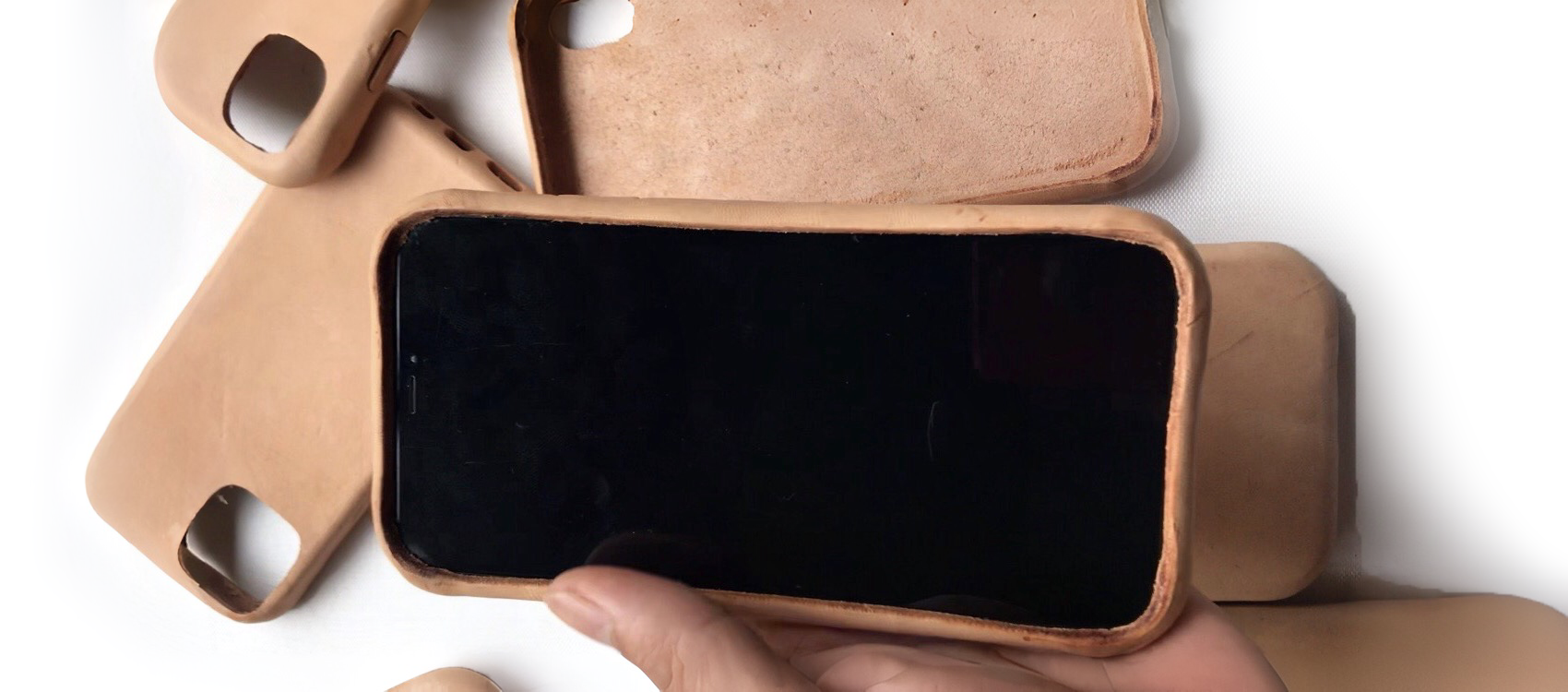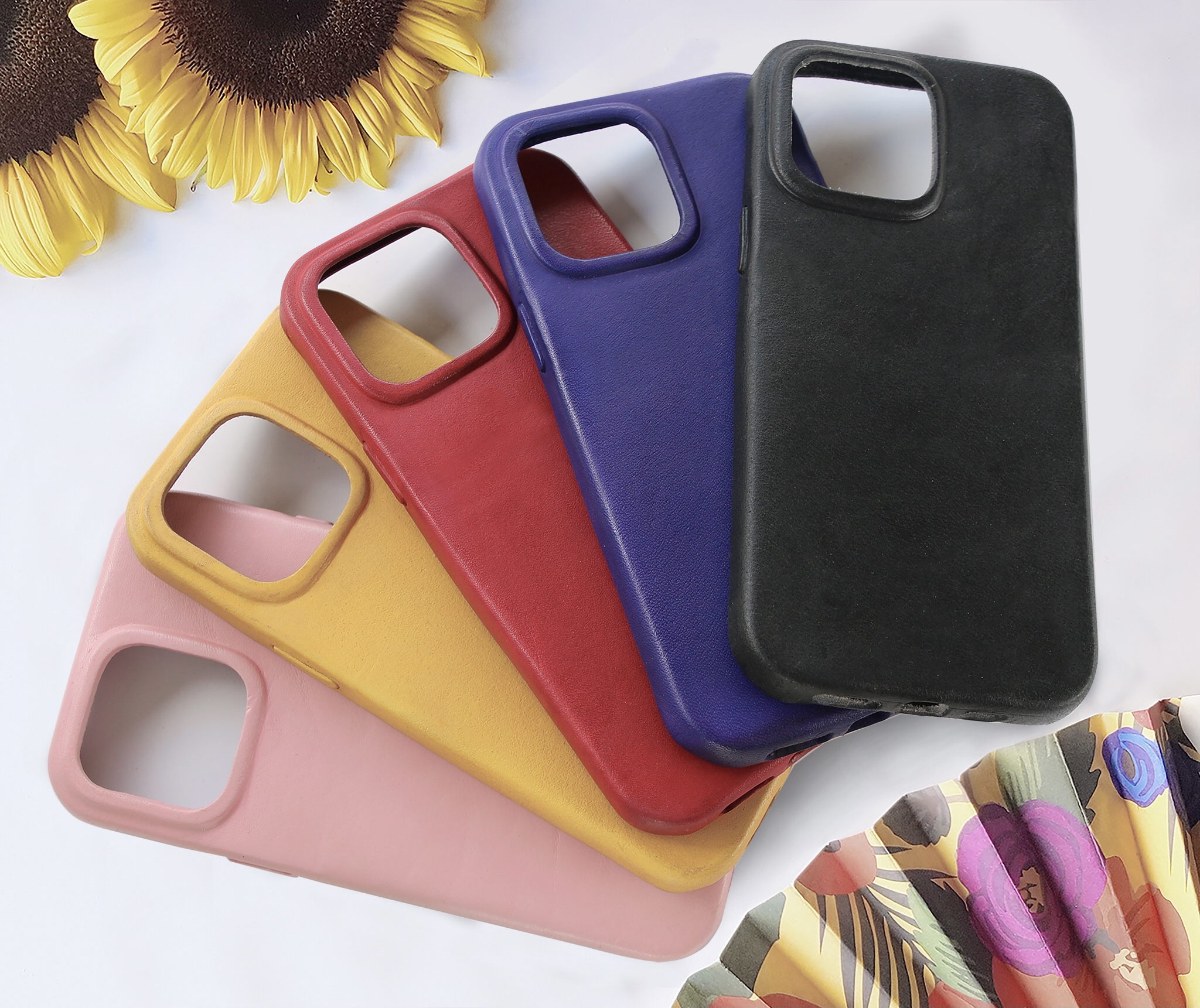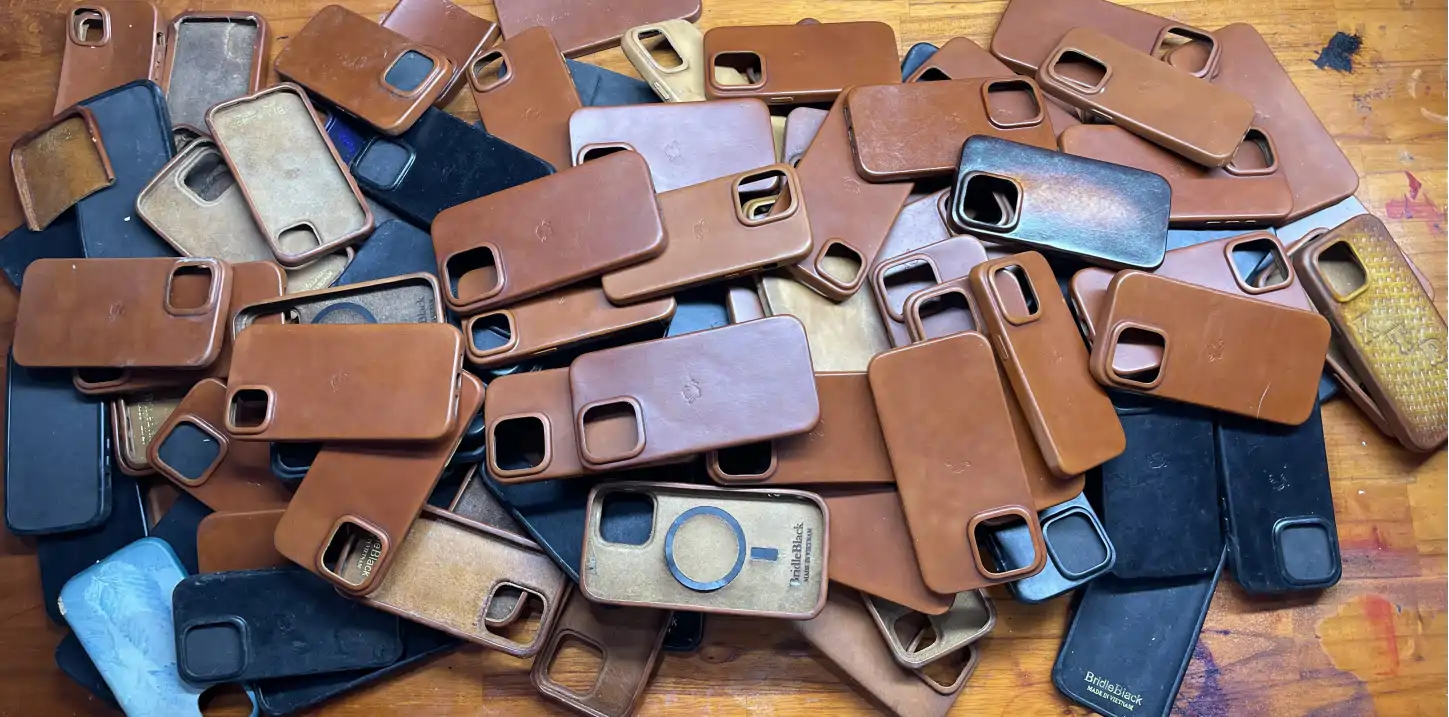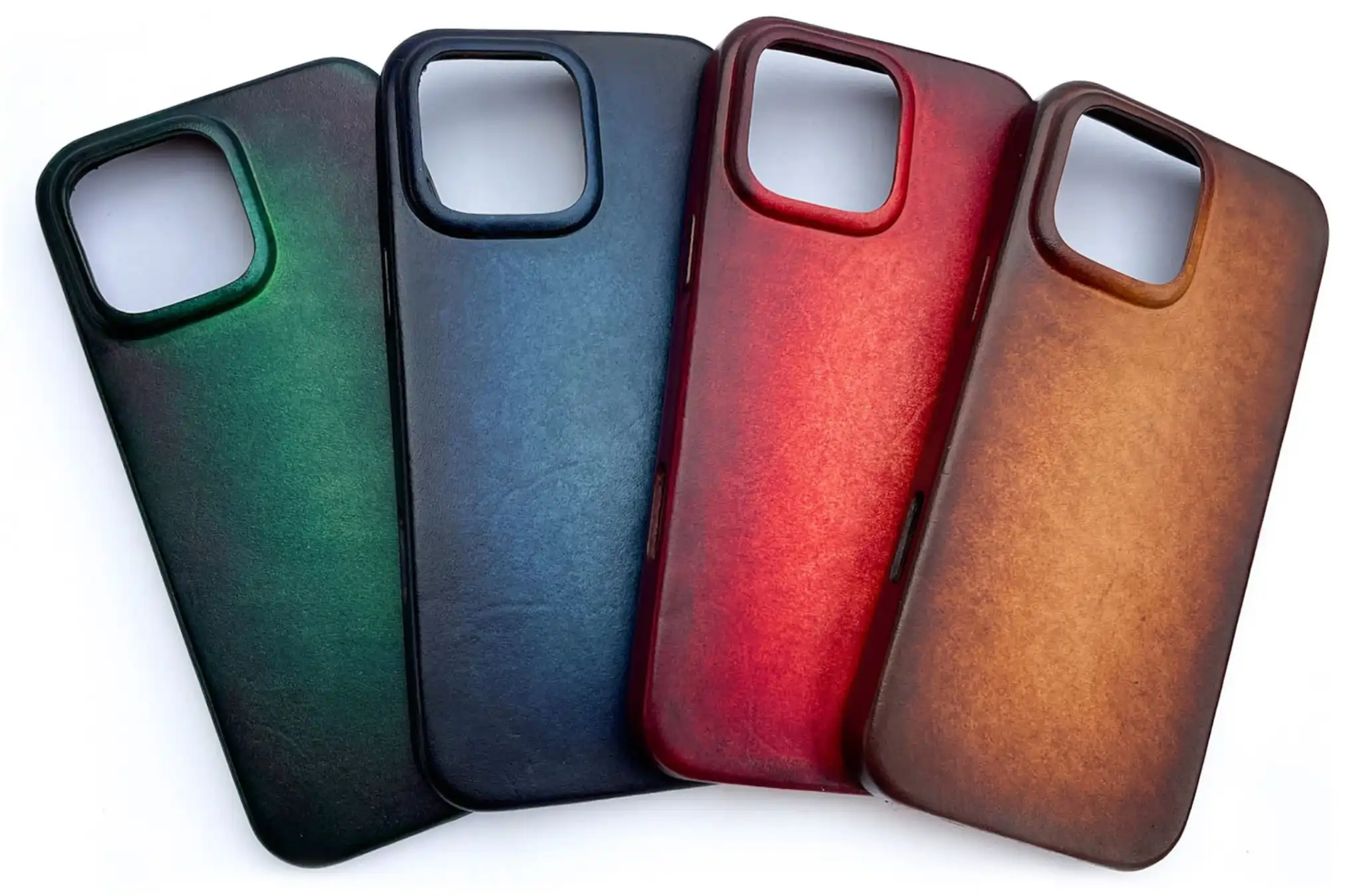Blog
The Journey of BridleBlack: Crafting the Perfect iPhone Leather Case with Over 30 Hours of Handmade Excellence
Is an $80 iPhone Leather Case Expensive?
Have you ever wondered if an $80 iPhone case from Apple, made with a thin leather layer glued onto a plastic shell, is expensive? At first, I didn’t think so—after all, it was an Apple iPhone case.
In 2019, I purchased an official Apple iPhone 11 Pro Max leather case for around $80 (~2 million VND). For the first month, I loved how it felt in my hands. However, the climate in Northern Vietnam posed a real challenge. The dry winter caused the leather to crack, making it rough and stiff. Then, as spring arrived with high humidity, the leather absorbed moisture, causing the adhesive to weaken and peel away from the plastic frame. To make matters worse, my sweaty hands accelerated the wear and tear, making the case look old and worn within just three months. That’s when I started wondering: Was there a better way?
The First Experiment: A Handmade iPhone Leather Case
As a fashion designer passionate about leather, I always had lambskin at home for making jackets. I attempted to restore my case by peeling off the old leather and re-wrapping it with lambskin. Since this was my first time working with phone cases, it took three attempts before I was satisfied. However, lambskin is thin (0.6mm – 0.8mm), and one day, I accidentally dropped my iPhone. The phone was fine, but the case tore, exposing the plastic inside. I felt disappointed.
Then, my then-girlfriend (now my wife) looked at it and asked, “Why isn’t there a 100% leather iPhone case?” I dismissed the idea, saying, “Leather this soft can’t form a case without a frame.” But her question lingered in my mind, sparking a curiosity I couldn’t ignore. I started researching and discovered vegetable-tanned (vegtan) leather, a type of leather traditionally used for carving.
The Turning Point: The Birth of a Fully Leather iPhone Case
In 2020, when the COVID-19 pandemic forced me to work from home, I had more free time. That’s when I seriously pursued making a 100% leather iPhone case. I ordered vegtan leather from local suppliers and searched for materials to create iPhone case molds. My first choice was wood. Thanks to my carpenter cousin, I designed an iPhone 11 Pro Max mold, printed the template on paper, and spent two days in a woodshop carving out the molds by hand.
Then came the challenge of cutting the leather. Shaping the edges to wrap around the phone smoothly was extremely difficult. After 13 failed attempts, I finally created a cut pattern that fit well. At that time, I was using 1.8mm – 2.0mm thick leather. I tried wet-molding it over the wooden form, but my early attempts failed miserably—the edges didn’t curve evenly, and the corners cracked. However, I saw potential: the leather could hold its shape. I persisted, and by the 34th attempt, I finally produced a case that fit snugly over the mold, albeit still rough in finish.
Another issue was that wooden molds were single-use, requiring constant replacements. I gave away my first handmade iPhone leather cases to friends and family. Although they weren’t perfect, they were the first fully leather cases with seamless curves that I had ever made.
From Hobby to Business: BridleBlack’s Expansion
My passion for both fashion design and leather crafting continued until early 2022, when COVID-19 restrictions eased. I decided to take things further by designing 3D iPhone molds and commissioning CNC-machined aluminum molds. This allowed me to reuse molds efficiently. I sent out more refined iPhone leather cases to friends, and their feedback was overwhelmingly positive. One friend asked, “Why don’t you sell these internationally?”
I posted my handmade iPhone cases in leathercraft groups on Facebook. Soon, leather artisans from the U.S. and Europe took notice. But success wasn’t immediate. Within a month, I received valuable critiques from skilled American leatherworkers.
-
Those in New Mexico, Nevada, and Wyoming (where winters are extremely dry) reported that my leather cases shrank, making them too tight for iPhones.
-
Meanwhile, in humid regions like South Carolina, North Carolina, Houston, Dallas, New York, and Florida, customers said the leather stretched and became loose over time.
This posed a serious challenge: How could I create an iPhone leather case that wouldn’t shrink in dry climates or expand in humid ones?
Initially, I considered applying a protective coating, but since phone cases are handled frequently, the coating would wear off. Instead, I studied vegtan leather further and visited local tanneries. I learned that vegtan leather is not fully tanned—it’s highly absorbent. In dry conditions, it shrinks; in humid environments, it expands.
The Breakthrough: Perfecting the Leather Case
In early 2023, I consulted with Vietnamese leather tanning experts, asking, “Can we fully tan vegtan leather after shaping it?” They laughed and replied, “Technically, no—but you can minimize its instability.” With their advice, I began experimenting with organic hardening agents. The results were promising: my iPhone leather cases became significantly more durable.
I tested them under high humidity—no stretching. Then, I placed them in a dry box for 24 hours—only slight warping occurred, and they still fit the iPhone perfectly.
By this time, I had improved my iPhone cases for the iPhone 13 and 14, designing better camera protection with a sleeker aesthetic. However, my eagerness led me to mass-produce cases using pre-dyed vegtan leather without thoroughly testing them first. The result? Customer complaints:
-
Edges were too thick.
-
Leather color faded after three months.
-
Cases shrank, making them unfit for iPhones.
-
Button covers were unresponsive.
I deeply regretted my decision. I recalled all defective units and compensated my customers.
I then fine-tuned the hardening formula and sent prototypes to fellow leather artisans for testing. After three months, I received great feedback—no more shrinking or stretching. However, the camera protection slightly protruded, losing its original squared-off design. Additionally, while humidity was no longer an issue, the cases no longer felt as firm.
Determined to perfect the design, I adjusted the hardening agent’s formula again, believing this would be the final fix. But unexpectedly, black stains appeared on the leather. After two weeks of testing, I discovered that the organic hardening compound reacted with heat in the drying process, causing discoloration. To solve this, I switched to air-drying the cases naturally, extending the production time from 12 hours to 30 hours.
The final test confirmed that shrinking and stretching were nearly eliminated. While no handmade product can be 100% perfect, I was finally satisfied with the durability and performance of my leather iPhone cases.
Each case must go through rigorous quality control and testing before it reaches you. If any defects are found, we remove them to ensure only the best products make it into your hands. We always put ourselves in the customer’s position, constantly striving to improve and refine our craft so that our products can go further and become even more user-friendly.
The Meaning Behind BridleBlack
My wife once told me, “These leather cases are like a horse’s bridle—it led you from a fashion designer with a stable, high-paying job to a true artisan.” And indeed, these iPhone leather cases have taken me through a journey of passion, failure, resilience, and growth over the past 3-4 years. That’s why I named my brand BridleBlack.
This is the story of BridleBlack—a journey of relentless craftsmanship, innovation, and a deep commitment to creating the finest handmade iPhone leather cases. Each case carries this journey within it. If you’re looking for a case that is 100% leather built to age beautifully, BridleBlack is for you.

